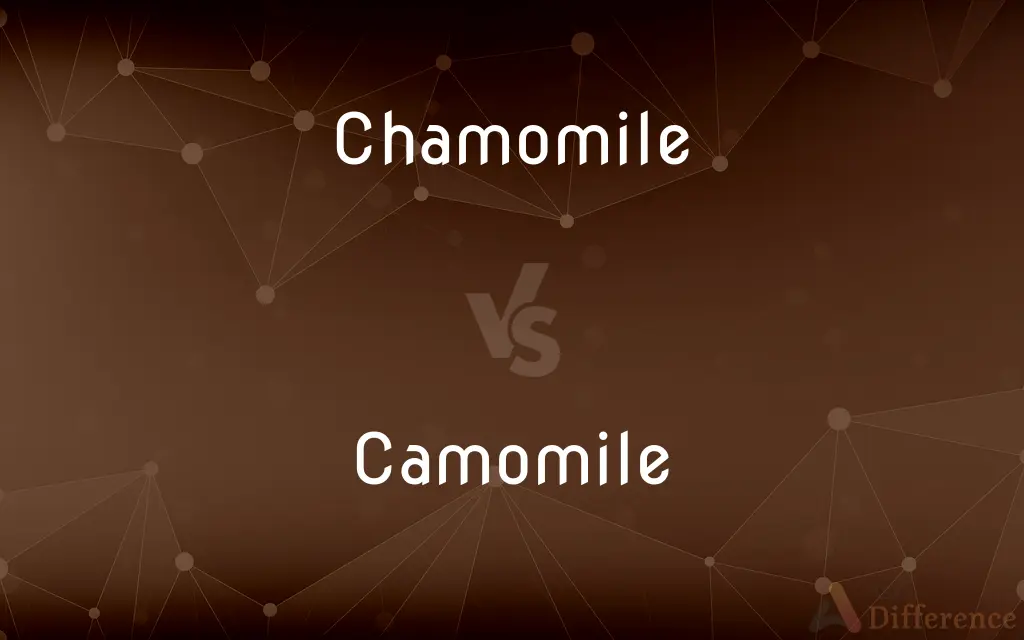Chamomile vs. Camomile — What's the Difference?
By Maham Liaqat & Fiza Rafique — Updated on April 7, 2024
"Chamomile" and "camomile" are different spellings of the same herb, known for its soothing properties.

Difference Between Chamomile and Camomile
Table of Contents
ADVERTISEMENT
Key Differences
Chamomile, often spelled as "camomile" in British English, refers to a group of daisy-like plants belonging to the Asteraceae family, which are used for their soothing, medicinal properties. Both spellings refer to the same plant and can be used interchangeably, with the choice of spelling typically depending on regional preferences. The herb is renowned for its calming effects and is commonly used in teas, cosmetics, and herbal remedies.
The plants known as chamomile are most commonly of two types: German chamomile (Matricaria recutita) and Roman chamomile (Chamaemelum nobile). Despite their similar names and uses, these two plants are distinct species with subtle differences in appearance and growth habits. German chamomile is an annual plant that tends to grow taller and has a more widespread distribution, while Roman chamomile is a low-growing perennial.
Both chamomile and camomile are celebrated for their gentle sedative qualities, making chamomile tea a popular beverage before bedtime to promote relaxation and improve sleep quality. The herb contains several compounds, such as bisabolol, chamazulene, and apigenin, that contribute to its anti-inflammatory, antispasmodic, and muscle relaxant properties.
In addition to its use in teas, chamomile is also used in various forms such as essential oils, ointments, and dietary supplements. It is applied topically to soothe skin irritations and used in aromatherapy for its stress-relieving scent. Despite its widespread use and natural origins, it's important to note that chamomile can cause allergic reactions in some individuals, especially those allergic to other plants in the Asteraceae family.
The spelling variations of chamomile and camomile reflect the broader differences between American and British English. Similar to other words with alternate spellings in these two dialects, the choice between chamomile and camomile often depends on the writer's or speaker's cultural and linguistic background.
ADVERTISEMENT
Comparison Chart
Spelling Variation
American English
British English
Plant Types
German (Matricaria recutita) and Roman (Chamaemelum nobile)
German (Matricaria recutita) and Roman (Chamaemelum nobile)
Uses
Tea, essential oil, dietary supplements, cosmetics
Tea, essential oil, dietary supplements, cosmetics
Properties
Anti-inflammatory, sedative, antispasmodic
Anti-inflammatory, sedative, antispasmodic
Prevalence
Globally recognized, with spelling depending on region
Globally recognized, with spelling depending on region
Compare with Definitions
Chamomile
Used in aromatherapy and cosmetics.
The lotion contained chamomile extract to soothe the skin.
Camomile
British English spelling for a soothing herb.
He grew camomile in his garden for homemade teas.
Chamomile
Known for anti-inflammatory properties.
Chamomile tea is often recommended for digestive upset.
Camomile
Used in natural remedies and skincare.
Camomile oil is a common ingredient in natural skincare products.
Chamomile
A herb used for its calming effects.
She sipped chamomile tea to unwind before bed.
Camomile
Employed in treating minor health issues.
Used camomile tea bags to relieve tired eyes.
Chamomile
Can be applied topically for skin conditions.
Applied chamomile compresses to the irritated area.
Camomile
Known for its gentle, floral aroma.
The room was filled with the fragrance of camomile.
Chamomile
Served as a mild sedative.
Drinking chamomile tea can help ease anxiety.
Camomile
Beneficial for relaxation and sleep.
A cup of camomile tea at night aids in sleep.
Chamomile
Chamomile (American English) or camomile (British English; see spelling differences) ( KAM-ə-myl or KAM-ə-meel), is the common name for several daisy-like plants of the family Asteraceae. Two of the species, Matricaria recutita and Anthemis nobilis, are commonly used to make herbal infusions for traditional medicine.
Camomile
Variant of chamomile.
Chamomile
An aromatic perennial herb (Chamaemelum nobile) in the composite family, native to Europe and the Mediterranean region, having feathery foliage and flower heads with white rays and yellow centers.
Camomile
Composite plant with a fragrance reminiscent of apples:
Chamomile
A similar, related Eurasian annual plant (Matricaria recutita).
Camomile
Matricaria recutita (formerly known as Matricaria chamomilla), German chamomile or Hungarian chamomile, with fragrant flowers used for tea, and as an herbal remedy.
Chamomile
The dried flower heads of either one of these plants, used to make an herbal tea and yielding an oil used in commercial flavorings and perfumery.
Camomile
Chamaemelum nobile (formerly Anthemis nobilis), English chamomile or Roman chamomile, a ground cover with fragrant foliage.
Chamomile
Alternative spelling of camomile
Camomile
Any of several other similar plants. (See below)
Chamomile
See Camomile.
Camomile
A genus of herbs (Anthemis) of the Composite family. The common camomile, Anthemis nobilis, is used as a popular remedy. Its flowers have a strong and fragrant and a bitter, aromatic taste. They are tonic, febrifugal, and in large doses emetic, and the volatile oil is carminative.
Chamomile
Eurasian plant apple-scented foliage and white-rayed flowers and feathery leaves used medicinally; in some classification systems placed in genus Anthemis
Camomile
Eurasian plant apple-scented foliage and white-rayed flowers and feathery leaves used medicinally; in some classification systems placed in genus Anthemis
Common Curiosities
Which spelling should I use, chamomile or camomile?
The choice depends on your regional spelling preference: "chamomile" for American English and "camomile" for British English.
Are chamomile and camomile the same thing?
Yes, they are different spellings of the same herb, known for its medicinal properties.
Can chamomile/camomile help with sleep?
Yes, it is widely used for its calming and sedative effects, which can promote better sleep.
Can everyone use chamomile/camomile?
While chamomile is safe for most people, it can cause allergic reactions in individuals sensitive to plants in the Asteraceae family.
How is chamomile/camomile used in cosmetics?
Its extract is used in skincare products for its soothing and anti-inflammatory properties.
Does chamomile/camomile have caffeine?
No, chamomile tea is naturally caffeine-free.
Can chamomile/camomile interact with medications?
It can interact with certain medications, so consult with a healthcare provider if you're taking medication.
Can chamomile/camomile tea be made from fresh plants?
Yes, tea can be brewed from both fresh and dried chamomile flowers.
Is there a difference between German chamomile and Roman camomile?
Yes, they are different species with similar uses but distinct growth habits and appearances.
Are there any side effects to using chamomile/camomile?
Side effects are rare but can include allergic reactions in susceptible individuals.
Is chamomile/camomile safe for children?
Chamomile tea is generally considered safe for children in small quantities, but it's best to consult a pediatrician first.
Does chamomile/camomile have any nutritional benefits?
While not nutrient-dense, it is valued for its calming properties and minimal calories.
How does chamomile/camomile benefit the skin?
Its anti-inflammatory and soothing properties make it beneficial for calming irritated or sensitive skin.
Can chamomile/camomile be used daily?
Yes, it can be used daily, but it's important to monitor for any adverse reactions.
Can I grow chamomile/camomile in my garden?
Yes, it can be easily grown in gardens and is often used for homemade teas and remedies.
Share Your Discovery

Previous Comparison
Sloth vs. Koala
Next Comparison
Stool vs. OttomanAuthor Spotlight
Written by
Maham LiaqatCo-written by
Fiza RafiqueFiza Rafique is a skilled content writer at AskDifference.com, where she meticulously refines and enhances written pieces. Drawing from her vast editorial expertise, Fiza ensures clarity, accuracy, and precision in every article. Passionate about language, she continually seeks to elevate the quality of content for readers worldwide.














































